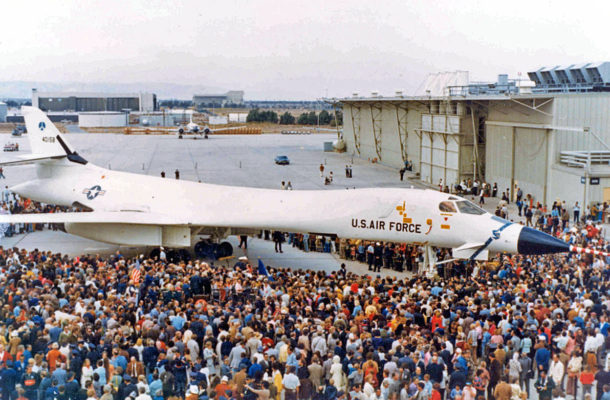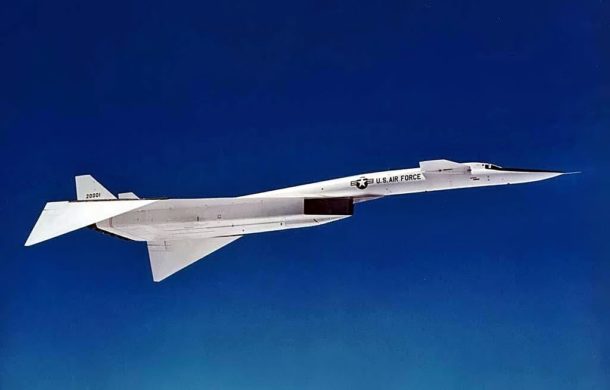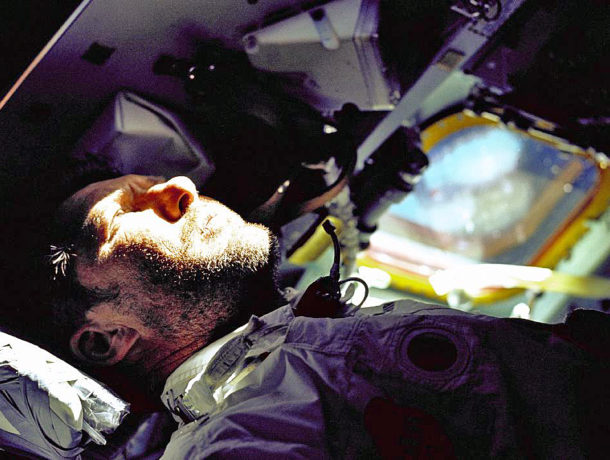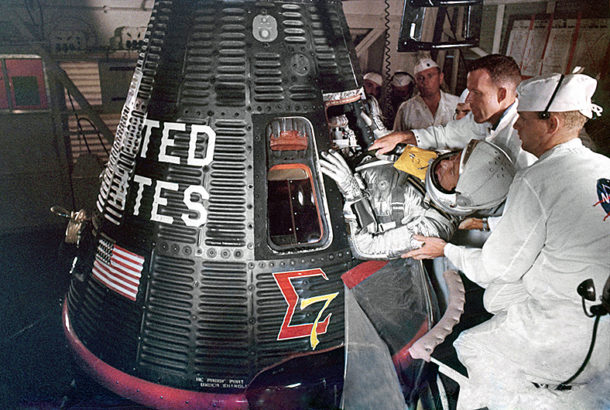
Forty-two years ago today, the official rollout of the first USAF/Rockwell B-1A multi-role strategic bomber took place at the contractor’s USAF Plant 42 facility in Palmdale, California. The swing-wing, supersonic aircraft was intended to replace the venerable USAF/Boeing B-52 Stratofortress.
The USAF/Rockwell B-1A Lancer was the product of 1960’s-era Air Force studies calling for a supersonic-capable, low-level penetration bomber. North American Rockwell was awarded a contract to manufacture and test four (4) prototype airframes (S/N’s 74-0158, 74-0159, 74-0160 and 76-0174) in 1970. General Electric was selected as the powerplant provider.
The B-1A was designed for both Mach 2.3 flight at 50,000 feet and Mach 0.85 flight at sea level. The aircraft was able to satisfy these requirements by virtue of several design features. Formost among these was the aircraft’s ability to adjust its wing sweep in flight. Coupled with its sleek, aerodynamically-efficient fuselage, this gave the aircraft very low wave drag. Another key element were the type’s quartet of General Electric F-101 turbofan engines which generated a total of 120,000 lbs of afterburner thrust at sea level. Thrust performance was optimized through the use of variable-geometry air intakes.
The B-1A measured 150.2 feet in length and featured a wing span that could be varied in flight from 136.7 feet (15-deg sweep) to 78.2 feet (67.5-deg sweep). Gross take-off and empty weights were 395,000 lbs and 115,000 lbs, respectively. Unrefueld range was 5,300 nm. The aircraft was designed to carry 75,000 lbs of nuclear and/or conventional ordnance internally and up to 40,000 lbs externally. Operationally, the B-1A’s four-man crew would consist of aircraft commander, pilot, offensive systems officer and defensive systems officer.
The No. 1 B-1A (S/N 74-0158) was rolled out for the public on Saturday, 26 October 1974. About 10,000 people attended this event which took place at Rockwell’s facility on USAF Plant 42 property in Palmdale, California. The big, white, sleek aircraft was visually stunning and bore a majestic presence. The media covered the event in some detail.
The No. 1 B-1A took-off for the first time from USAF Plant 42 on Monday, 23 December 1974. The flight test aircrew included Charles Bock, Jr. (aircraft commander), Col. Emil (Ted) Sturmthal (pilot) and Richard Abrams (flight test engineer). The aircraft’s landing gear was not retracted and wing sweep was not varied during this initial flight test. These systems were operated on the type’s second flight test which occurred on Thursday, 23 January 1975.
Each of the B-1A prototypes served a distinct role in the aircraft’s flight test program. The No. 1 aircraft (74-0158) was the flying qualities evaluation testbed. It flew 79 times (405.3 hours) and was the first B-1A to hit Mach 1.5 (Oct 1975) as well as Mach 2 (Apr 1976). Aircraft No. 2 (S/N 74-0159) evaluated structural loading parameters, flew 60 times (282.5 hours), and achieved the highest Mach number of any B-1A aircraft (Mach 2.22 on Oct 1978). Aircraft No. 3 (S/N 74-0160) amassed 138 flights (829.4 hours) as an offensive and defensive systems testbed. Aircraft No. 4 (76-0174) had a similar role in that it tested essentially operational versions of the offensive and defensive systems. It flew 70 times (378 hours).
The B-1A program was cancelled by the Carter Administration in June of 1977. While it never attained operational status, the aircraft broke new ground in mutiple areas including aircraft design, aerodynamics, flight performance, and electronic warfare. Indeed, the multiple technological capabilities that it pioneered were ultimately exploited in the type’s direct heir; today’s USAF B-1B Lancer.

Fifty-one years ago this month, the USAF/North American XB-70A Valkyrie reached three times the speed of sound for the first time. The historic aviation achievement took place on the 18th anniversary of the breaking of the sound barrier by the USAF/Bell XS-1.
When it comes to legendary aircraft, aviation enthusiasts speak in almost reverent terms about the XB-70A Valkyrie. Indeed, few aircraft have evoked such utter awe or symbolized better the profound majesty of flight than the “The Great White Bird”. Though its flight history was brief, the XB-70A’s influence on aviation has proven to be of enduring worth.
The Valkyrie measured 185 feet in length, had a wingspan of 105 feet and an empty weight of 210,000 pounds. With a GTOW of 550,000 pounds, it was the heaviest supersonic-capable aircraft of all-time. The aircraft was powered by a six-pack of General Electric YJ93-GE-3 turbojets generating more than 172,000 pounds of thrust in afterburner.
To enhance lift-to-drag ratio and directional stability at high Mach number, the Valkyrie was configured with wing tips that could be deflected downward as much as 65 degrees. Each wing tip was the size of an USAF/Convair B-58A Hustler wing panel. To this day, the XB-70A deflectable wing tip is the largest control surface ever used on an aircraft.
The XB-70A was originally intended to be a supersonic strategic bomber. The aircraft’s mission was to penetrate Soviet airspace at Mach 3 and deliver nuclear ordnance from an altitude of 72,000 feet. However, the rapid ascendancy of Soviet surface-to-air missile capability would compromise the type’s military mission before it even flew.
As a consequence of the above, the Valkyrie ultimately became a high-speed flight research aircraft. Only two (2) copies were constructed and flown. Ship No. 1 (S/N 62-0001) made its maiden flight on Monday, 21 September 1964 while Ship No. 2 (62-0207) first took to the air on Saturday, 17 July 1965.
XB-70A Ship No. 1 became the first Valkyrie to hit Mach 3. It did so while flying at an altitude of 70,000 feet on Thursday, 14 October 1965. The flight crew consisted of North American Aviation test pilot Alvin S. White (aircraft commander) and USAF Colonel Joseph Cotton (co-pilot).
The XB-70A aircraft flew all of their flight research missions out of Edwards Air Force Base in California. Between September of 1964 and February of 1969, a total of 129 XB-70A research flights took places; 83 by Ship No. 1 and 46 by Ship No. 2. A total of nearly 253 flight hours was amassed by the aircraft.
The XB-70A Program made significant contributions to high-speed aircraft technology including aerodynamics, aerodynamic heating, flight controls, structures, materials, and air-breathing propulsion. Lessons-learned from its flight research have been applied to numerous aircraft developments including the B-1A, American SST, Concorde and the TU-144.
XB-70A Ship No. 1 survived the flight test program while Ship No. 2 did not. The latter was destroyed in a mid-air collision with a NASA F-104N on Wednesday, 08 June 1966. Today, XB-70A Ship No. 1 can be seen at the National Museum of the United States Air Force at Wright-Patterson Air Force Base in Dayton, Ohio.

Forty-eight years ago this month, NASA successfully conducted the first manned Apollo Earth-orbital mission with the flight of Apollo 7. This mission was a critically-important milestone along the path to the first manned lunar landing in July 1969.
The launch of Apollo 7 took place from Launch Complex 34 at Cape Canaveral Air Force Station, Florida at 15:02:45 UTC on Friday, 11 October 1968. The flight crew consisted of NASA astronauts Walter M. Schirra, Donn F. Eisele, and R. Walter Cunningham. Their primary goal was to thoroughly qualify the new Apollo Block II Command Module (CM) during 11 days in space.
Apollo 7 was not only the first flight of the Block II CM, but in fact the first manned mission in the Apollo Program. Apollo 7 also featured the first use of the Saturn IB launch vehicle in a manned mission. Apollo 7’s critical nature stemmed from the tragic Apollo 1 fire that took the lives of Virgil I. (Gus) Grissom, Edward H. White II, and Roger B. Chaffee on Friday, 27 January 1967.
The Apollo 1 fire was attributed to numerous deficiencies in the design, construction, and testing of its Block I CM. The Block II spacecraft flown on Apollo 7 was a major redesign of the Apollo Command Module and was in every sense superior to the Block I vehicle. However, it had taken 21 months to return to flight status and the Nation’s goal of a manned lunar landing within the decade of the 1960’s was in serious jeopardy.
The Apollo 7 crew orbited the Earth 163 times at an orbital altitude that varied between 125 and 160 nautical miles. In that time, they rigorously tested every aspect of their Block II CM. This testing included 8 firings of the Service Propulsion System (SPS) while in orbit. Apollo 7 splashdown occurred in the Atlantic Ocean near the Bermuda Islands at 11:11:48 UTC on Tuesday, 22 October 1968.
The Nation’s Lunar Landing Program overwhelmingly got the unqualified success that it desperately needed from the Apollo 7 mission. The Apollo Block II CM would provide yeoman service throughout the time of Apollo. The spacecraft would also go on to see service in the Skylab and Apollo-Soyuz Test Project programs.
While the technical performance of the Apollo 7 crew was unquestionably superb, their interaction with Mission Control at Johnson Spacecraft Center (JSC) in Houston, Texas was quite strained. The crew suffered from head colds through much of the mission and the food quality was poor. Coupled with Houston’s incessant attempts to cramp more tasks into each moment of the mission, Apollo 7 Commander Schirra took control of his ship and made the ultimate decisions as to what work would be performed onboard the spacecraft.
The flight of Apollo 7 would be Wally Schirra’s last mission in space as he had announced prior to flight. Schirra holds the distinction of being the only astronaut to have flown Mercury, Gemini, and Apollo missions.
Interestingly, Apollo 7 was not only Schirra’s last time in space, but it was Donn Eisele’s and Walt Cunningham’s first and last space mission as well. That there is a direct connection between this historical fact and the crew’s insubordinate behavior during Apollo 7 is obvious to the inquiring mind.

Fifty-four years ago this week, Mercury Astronaut Walter M. Schirra, Jr. orbited the Earth six (6) times in his Mercury spacecraft code-named Sigma 7. The near-perfect 9-hour spaceflight was the United States’ third manned orbital mission flown within a period of eight (8) months.
Project Mercury was United States’ first manned spaceflight program. This historic pioneering space effort helped lay the foundation for America’s quest for the Moon. A total of six (6) missions (2 sub-orbital and 4 orbital) was flown between May of 1961 and May of 1963.
The Mercury Spacecraft measured 11.5 feet in length and had a diameter of 6.2 feet. Orbital weight was roughly 3,000 pounds. With a cockpit volume of only 60 cubic feet, an astronaut’s corporeal fit inside the spacecraft was exceedingly tight. Vehicle entry and egress was a real shoe-horning process. It is not complete hyperbole to say that, once inside, an astronaut wore, more than rode in, the Mercury space vehicle.
Despite its dimunitive size, the Mercury Spacecraft was an able spacefaring ship. Indeed, it was configured with a complete suite of life support, navigation, attitude control, communications, deboost, recovery and thermal protection systems. Aided by a vast national mission support team, recovery force, and world-wide tracking system, the Mercury spaceflight effort was entirely successful in establishing America in space.
America’s first astronauts were known as the Mercury Seven. History records their names; Shepard, Grissom, Glenn, Carpenter, Schirra, Cooper and Slayton. In the tense 1960’s Space Race with the Soviet Union, these men were indeed America’s Single-Combat Warriors immortalized by writer Tom Wolfe in his classic, The Right Stuff.
Mercury-Atlas No. 8 (MA-8) was the fifth Mercury mission. Whereas the two (2) previous flights had been three (3) orbit missions, MA-8 was scheduled to orbit the Earth six (6) times. The focus would be on spacecraft operations instead of space science. The intent was to verify that the Mercury spacecraft could be cleared for an orbital mission duration of at least 24 hours on the very next flight
As was the custom for a Mercury astronaut, Schirra personally named his orbital steed. As such, Schirra chose the name Sigma 7. The term Sigma, the Greek mathematical symbol for summation, signified a summation or culmination of flight experience and engineering development that led to a mature Mercury Spacecraft system. The numeral 7 represented the Mercury Seven.
The MA-8 mission began with lift-off from Cape Canaveral’s LC-14 at 12:15:12 UTC on Wednesday, 03 October 1962. The Atlas D launch vehicle placed Schirra into a 152.8-nm x 86.9-nm orbit. Once in orbit, Schirra quickly got down to business. This included tracking the Atlas booster, maneuvering the spacecraft, observing and photographing the Earth, and conducting various scientific experiments.
Schirra did a particularly good job at conserving the precious supply of Reaction Control System (RCS) fuel. One of the MA-8 objectives had been to do so. In fact, Schirra conserved fuel even more efficiently than planned. Other than an annoying and uncomfortable spacesuit heating problem that occurred several times, the entire MA-8 mission was what Schirra would ultimately call “textbook”.
MA-8 retro-fire occurred at 21:07:12 UTC. During the reentry, the automatic rate stabilization system damped spacecraft pitch and yaw oscillations. Drogue and main parachute deployment took place at 40,000 feet and 15,000 feet, respectively. Splashdown in the Pacific Ocean occurred 1,200 nm northwest of Hawaii at 21:28:22 UTC.
The success of MA-8 paved the way to Gordon Cooper’s historic 22-orbit, 34-hour MA-9 mission in May of 1963. The Gemini and Apollo Programs would soon follow. Wally Schirra would play a big part in both. He commanded the historic Gemini 6 orbital rendezvous mission in December of 1965. Schirra also went on to command the critical Apollo 7 mission in October of 1968.
Wally Schirra was the only member of the Mercury Seven to orbit the Earth in Mercury, Gemini and Apollo spacecraft. He left this earthly scene in May 2007 at the age of 84.




